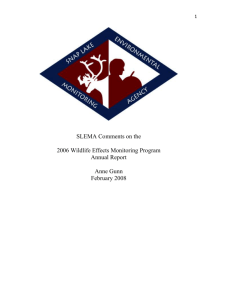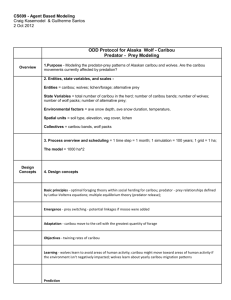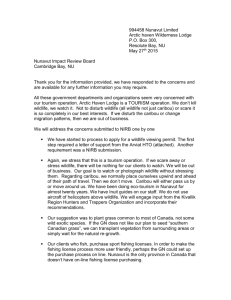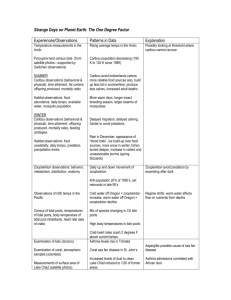Reference list - The CircumArctic Rangifer Monitoring and
advertisement
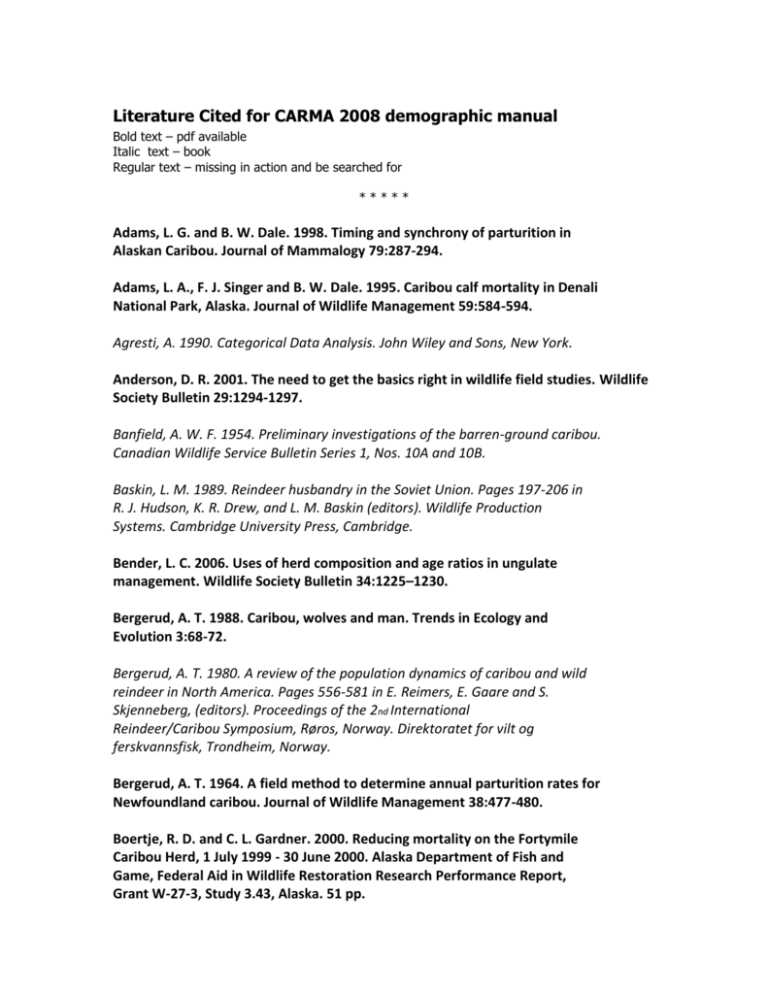
Literature Cited for CARMA 2008 demographic manual Bold text – pdf available Italic text – book Regular text – missing in action and be searched for ***** Adams, L. G. and B. W. Dale. 1998. Timing and synchrony of parturition in Alaskan Caribou. Journal of Mammalogy 79:287-294. Adams, L. A., F. J. Singer and B. W. Dale. 1995. Caribou calf mortality in Denali National Park, Alaska. Journal of Wildlife Management 59:584-594. Agresti, A. 1990. Categorical Data Analysis. John Wiley and Sons, New York. Anderson, D. R. 2001. The need to get the basics right in wildlife field studies. Wildlife Society Bulletin 29:1294-1297. Banfield, A. W. F. 1954. Preliminary investigations of the barren-ground caribou. Canadian Wildlife Service Bulletin Series 1, Nos. 10A and 10B. Baskin, L. M. 1989. Reindeer husbandry in the Soviet Union. Pages 197-206 in R. J. Hudson, K. R. Drew, and L. M. Baskin (editors). Wildlife Production Systems. Cambridge University Press, Cambridge. Bender, L. C. 2006. Uses of herd composition and age ratios in ungulate management. Wildlife Society Bulletin 34:1225–1230. Bergerud, A. T. 1988. Caribou, wolves and man. Trends in Ecology and Evolution 3:68-72. Bergerud, A. T. 1980. A review of the population dynamics of caribou and wild reindeer in North America. Pages 556-581 in E. Reimers, E. Gaare and S. Skjenneberg, (editors). Proceedings of the 2nd International Reindeer/Caribou Symposium, Røros, Norway. Direktoratet for vilt og ferskvannsfisk, Trondheim, Norway. Bergerud, A. T. 1964. A field method to determine annual parturition rates for Newfoundland caribou. Journal of Wildlife Management 38:477-480. Boertje, R. D. and C. L. Gardner. 2000. Reducing mortality on the Fortymile Caribou Herd, 1 July 1999 - 30 June 2000. Alaska Department of Fish and Game, Federal Aid in Wildlife Restoration Research Performance Report, Grant W-27-3, Study 3.43, Alaska. 51 pp. Bonenfant, C., J.-M. Gaillard, F. Klein, and J.-L. Hamann. 2005. Can we use the young:female ratio to infer ungulate population dynamics? an empirical test using red deer Cervus elaphus as a model. Journal of Applied Ecology 42:361–370. Boudreau, S., S. Payette, C. Morneau, and S. Couturier. 2003. Recent decline of the George River caribou herd as revealed by tree-ring analysis. Arctic, Antarctic, and Alpine Research 35:187-195. Boulanger, J. and A. Gunn. 2007. Exploring possible mechanisms for the decline of the Bathurst herd of barren-ground caribou using demographic modeling. Northwest Territories Department of Environment and Natural Resources Manuscript Report No. 175. Yellowknife, NT. 56 pp. Boulanger, J., A. Gunn, and M. Campbell. 2003. Survival rate estimates for adult female caribou in four herds of barren-ground caribou using radio-collared individuals, Northwest Territories and Nunavut. Unpublished report for Governments of Northwest Territories and Nunavat. Boulet, M., S. Couturier, S. D. Côté, R. Otto, and L. Bernatchez. 2005. Gene flow patterns between migratory, montane, and sedentary caribou herds of northern Québec and Labrador: lessons from satellite tracking, microsatellite genotyping, and population simulations. Ministère des Ressources naturelles et de la Faune, Direction de la recherche sur la faune. Québec. 46 pp. Brooks, C., C. Bonyongo, and S. Harris. 2008. Effects of global positioning system collar weight on zebra behavior and location error. Journal of Wildlife Management 72: 527–534. Brown, D. and P. Rothery. 1993. Models in Biology: Mathematics, Statistics, and Computing. Wiley, New York. Buckland, S. T., D. R. Anderson, K. P. Burnham, and J. L. Laake. 1993. Distance sampling: estimating abundance of biological populations. Chapman and Hall, London. 446 pp. http://www.colostate.edu/Dept/coopunit/download.html Bullock, J. M., R. E. Kenward, and R. S. Hails (editors). 2002. Dispersal Ecology. 42nd Symposium of the British Ecological Society, Cambridge University Press, Cambridge. 475 pp. Byers, T. 1999. Perspectives of aboriginal peoples on wildlife research. Wildlife Society Bulletin 27: 671-675. Cameron, R. D. 1994. Reproductive pauses by female caribou. Journal of Mammalogy 75:10-13. Cameron, R. D., K. R. Whitten, W. T. Smith, and D. J. Reed. 1985. Sampling errors associated with aerial transect surveys of caribou. McGill Subarctic Research Papers 40:273-284. Carroll, G. M., L. S. Parrett, J. C. George, and D. A. Yokel. 2005. Calving distribution of the Teshekpuk caribou herd, 1994-2003. Rangifer Special Issue 16:27-35. Caughley, G. 1977. Analysis of Vertebrate Populations. John Wiley & Sons, New York. 234 pp. Caughley, G. 1974a. Bias in aerial survey. Journal of Wildlife Management 38:921-933. Caughley, G. 1974b. Interpretation of age ratios. Journal of Wildlife Management 38:557-562. Caughley, G. and A. R. E. Sinclair. 1994. Wildlife Ecology and Management. Blackwell Scientific Publications, Boston, MA. 344 pp. Clegg, S. M., J. F. Kelly, M. Kimura, and T.B. Smith. 2003. Combining genetic markers and stable isotopes to reveal population connectivity and migration patterns in a Neotropical migrant, Wilson’s warbler (Wilsonia pusilla). Molecular Ecology, 12:819-830. Cochran, W.G. 1977. Sampling Techniques (Third edition). Wiley, New York. Coulson, T., J. M. Gaillard, and M. Festa-Bianchet. 2005. Decomposing the variation in population growth into contributions from multiple demographic rates. Journal of Animal Ecology 74:789-901. Couturier, S., J. Huot, S. D. Côté, Q. van Ginhoven, R. Otto, and D. Jean. In press. Populations, metapopulations, ecotypes and subspecies of caribou in QuébecLabrador: an exploratory discussion. In K. McFarlane, A. Gunn, and C. Strobeck (editors). Proceedings from the Caribou Genetics and Relationships Workshop, Edmonton, Alberta, 8-9 March 2003. Northwest Territories Department of Environment and Natural Resources Manuscript Report. Yellowknife, NT. Couturier, S., R. Courtois, H. Crépeau, L.-P. Rivest, and S. Luttich. 1996. Calving photocensus of the Rivière George Caribou herd and comparison with an independent census. Rangifer Special Issue 9:283-296. Côté, S. D., J. F. Dallas, F. Marshall, R. J. Irvine, R. Langvatn, and S. D. Albon. 2002. Microsatellite DNA evidence for genetic drift and philopatry in Svalbard reindeer Molecular Ecology 11:1923–1930. Cuyler, C., M. Rosing, R. Heinrich, J. Egede, and L. Mathæussen. 2007. Status of two West Greenland caribou populations in 2006: 1) Ameralik, 2) Qeqertarsuatsiaat. Greenland Institute of Natural Resources Technical Report No. 67. 143 pp. (Part I: 1-74; Part II: 75-143). Cuyler, C., M. Rosing, J. Egede, R. Heinrich, and H. Mølgaard. 2005. Status of two West Greenland caribou populations 2005: 1) Akia-Maniitsoq, 2) Kangerlussuaq-Sisimiut. Greenland Institute of Natural Resources Technical Report No. 61. 108 pp. (Part I: 1-64; Part II: 1-44). Cuyler, C., M. Rosing, J. D. C. Linnell, P. M. Lund, A. Loison, and A. Landa. 2004. Neria & Qassit caribou minimum count and herd structure in 2000, Paamiut, West Greenland. Greenland Institute of Natural Resources Technical Report No. 48. 46 pp. Cuyler, C., M. Rosing, J. D. C. Linnell, P. M. Lund, P. Jordoy, A. Loison, and A. Landa. 2003. Status of three West Greenland caribou populations 2001: 1) Akia-Maniitsoq, 2) Ameralik, 3) Qeqertarsuatsiaat. Greenland Institute of Natural Resources Technical Report No. 46. 73 pp. Cuyler, C., M. Rosing, J. D. C. Linnell, A. Loison, T. Ingerslev, and A. Landa. 2002. Status of the Kangerlussuaq-Sisimiut caribou population (Rangifer tarandus groenlandicus) in 2000, West Greenland. Greenland Institute of Natural Resources Technical Report No. 42. 52 pp. Dau, J. 2007. Caribou survey-inventory management report. Units 21D, 22A, 22B, 22C, 22D, 22E, 23, 24 and 26A caribou management report. Pages 174-231 in P. Harper (editor). Caribou Management Report of Surveys and Inventories Activities 1 July 2004-30 June 2006. Alaska Department of Fish and Game, Juneau, AK. Dau, J. 2005. Caribou Management Report 1 July 2002-30 June 2004, Western Arctic Herd. Alaska Department of Fish and Game, Juneau, AK. http://www.wildlife.alaska.gov/pubs/techpubs/mgt_rpts/ca05_wah.pdf Dau, J. 2003. Western Arctic herd caribou management. Pages 204-251 in C. Healy (editor). Caribou Management Report of survey-inventory activities 1 July 2000-30 June 2002. Alaska Department of Fish and Game, Juneau, AK. Dau, J. 1997. Caribou survey-inventory management report. Units 21D, 22A, 22B, 22C, 22D, 22E, 23, 24 and 26A caribou management report. Pages 158-185 in M.V. Hicks (editor). Caribou. Alaska Department of Fish and Game Federal Aid Wildlife Restoration Survey-Inventory Activities 1 July 1994-30 June 1996, Juneau, AK. Davis, J. L. and P. Valkenburg. 1985. Qualitative and quantitative aspects of natural mortality of the western Arctic caribou herd. Final Report Federal Aid in Wildlife Restoration Project W-17-11, W-21-2, W-22-1, W-22-2, W-22-3, Job 3.24R, Alaska Department of Fish and Game, Juneau, AK. 71 pp. Davis, J. L., P. Valkenburg, and S. Harbo, Jr. 1979. Refinement of the aerial photo-direct count extrapolation caribou census technique. Final Report Federal Aid in Wildlife Restoration Project W-17-11, Job 3.25R, Alaska Department of Fish and Game, Juneau, AK. 23 pp. Devineau, O., R. Choquet, and J.-D. Lebreton. 2006. Planning capture–recapture studies: straightforward precision, bias, and power calculations. Wildlife Society Bulletin 34:1028-1035. Festa-Bianchet, M., J.-M. Gaillard, and S. D. Côté. 2003. Variable age structure and apparent density dependence in survival of adult ungulates. Journal of Animal Ecology 72:640–649. Fong, D. W., W. E. Mercer, M. McGrath, and O. Forsey. 1985. A comparison of strip transect and random quadrat population estimate for Newfoundland caribou herds. McGill Subarctic Research Papers 40:229-238. Freddy, D. J. and D. C. Bowden. 1983. Sampling mule deer pellet-group density in juniper-pinyon woodland. Journal of Wildlife Management 47:476-485. Fuller, T. K. 1991. Do pellet counts index white-tailed deer numbers and population change? Journal of Wildlife Management 55:393-396. Gaillard, J.-M., M. Festa-Bianchet, N. G. Yoccoz, A. Loison, and C. Toigo. 2000. Temporal variation in fitness components and population dynamics of large herbivores. Annual Review of Ecology and Systematics 31:367-393. Gaillard, J.-M., M. Festa-Bianchet, and N. G. Yoccoz. 1998. Population dynamics of large herbivores: variable recruitment with constant adult survival. Trends in Ecology and Evolution 13:58-63. Gasaway, W. C., S. D. Dubois, D. J. Reed, and S. J. Harbo. 1986. Estimating moose population parameters from aerial surveys. Biological Papers of the University of Alaska No 22:1-108. Gerrodette, T. 1993. TRENDS: software for a power analysis of linear regression. Wildlife Society Bulletin 21:515-516. Available at: http://swfsc.noaa.gov/textblock.aspx?Division=PRD&ParentMenuId=228&id =4740 Gerrodette, T. 1987. A power analysis for detecting trends. Ecology 68:1364-1372. Gibb, J. P., H. L. Snell, and C. E. Causton.1999. Effective monitoring for adaptive wildlife management: lessons from the Galápagos Islands. Journal of Wildlife Management 63:1055-1065. Goudreault, F. and S. Luttich. 1985. The impact of simultaneous handling of adult caribou cows (Rangifer tarandus) and their calves on the post-release mother infant bond. McGill Subarctic Research Papers 40:131-152. Greenwood, P. J. and P. Harvey. 1982. The natal and breeding dispersal of birds. Annual Review of Ecology and Systematics 13:1-21. Griffith, B., D. C. Douglas, N. E. Walsh, D. D. Young, T. R. McCabe, D. E. Russell, R. G. White, R. D. Cameron, and K. R. Whitten. 2002. The Porcupine caribou herd. Pages 8-37 in D. C. Douglas, P. E. Reynolds, and E. B. Rhode (editors). Arctic Refuge Coastal Plain Terrestrial Wildlife Research Summaries. U. S. Geological Survey, Biological Resources Division, Biological Science Report USGS/BRD BSR-2002-0001. Guenzel, R. J. 1997. Estimating pronghorn abundance using aerial line transect sampling. Wyoming Game and Fish Department, Cheyenne, WY. 173 pp. http://www.ruwpa.st-and.ac.uk/distance.book/pronghorn.html Gunn, A., K. G. Poole, and J. Wierzchowski. 2008. A geostatistical analysis for the patterns of caribou occupancy on the Bathurst calving grounds 1966- 2007. Unpublished report submitted to Indian and Northern Affairs Canada, Yellowknife, NT. 51 pp. Gunn, A., J. Nishi, J. Boulanger, and J. Williams. 2005a. An estimate of breeding females in the Bathurst herd of barren-ground caribou, June 2003. Northwest Territories Department of Resources, Wildlife and Economic Development Manuscript Report No. 164. Yellowknife, NT. 75 pp. Gunn, A., J. Boulanger, and J. Williams. 2005b. Calf survival and fall sex ratios in the Bathurst herd of barren-ground caribou 2000-04. Northwest Territories Department of Resources, Wildlife and Economic Development Manuscript Report No. 163. Yellowknife, NT. 89 pp. Harris, N. C., M. J. Kauffman, and L. S. Mills. 2008. Inferences about ungulate population dynamics derived from age ratios. Journal of Wildlife Management 72:1143-1151. Haskell, S. P. and W. B. Ballard. 2007. Modeling the Western Arctic Caribou herd during a positive growth phase: potential effects of wolves and radio-collars. Journal of Wildlife Management 71:619–627. Hatter, I. W. and W. A. Bergerud. 1991. Moose recruitment, adult mortality and rate of change. Alces 27:65-73. Heard, D. C. 1987a. Allocation of effort in a stratified survey design. Northwest Territories Department of Renewable Resources Manuscript Report. Yellowknife, NT. 9 pp. Heard, D. C. 1987b. A simple formula for calculating the variance of products. Northwest Territories Department of Renewable Resources Manuscript Report. Yellowknife, NT. 5 pp. Heard, D. C. 1985. Caribou census methods used in the Northwest Territories. McGill Subarctic Research Papers 40:229-238. Heard, D. C. and M. Williams. 1991. Caribou project summary and review (Part 2) – Population Dynamics. Unpublished report by Department of Renewable Resources, Government of the Northwest Territories. Yellowknife, NT. 47 pp. Heard, D. C. and M. Williams. 1990. Caribou project summary and review (Part 1). Unpublished report by Department of Renewable Resources, Government of the Northwest Territories. Yellowknife, NT. 53 pp. Hinkes M. T., G. H. Collins, L. J. Van Daele, S. D. Kovach, A. R. Aderman, J. D. Woolington, and R. J. Seavoy. 2005. Influence of population growth on caribou herd identity, calving ground fidelity, and behaviour. Journal of Wildlife Management 69:1147-1162. Howard, W. E. 1960. Innate and environmental dispersal of individual vertebrates. American Midland Naturalist 63:152-161. Jenkins, K. J. and N. L. Barten. 2005. Demography and decline of the Mentasta caribou herd in Alaska. Canadian Journal of Zoology 83:1174-1188. Johnson, B. K. 1991. Use of aerial line transect surveys to estimate pronghorn populations in Wyoming. Wildlife Society Bulletin 19: 315-321. Jolly, G.M. 1969. Sampling method for aerial census of wildlife populations. East African Agricultural and Forestry Journal 34:46-49. Kelleyhouse, R. A. 2001. Calving ground habitat selection: Teshekpuk Lake and Western Arctic caribou herds. M.Sc. thesis, University of Alaska, Fairbanks, AK. 140 pp. Kleinbaum, D. G. and L. L. Kupper. 1978. Applied Regression Analysis and Other Multivariable Methods. Wadsworth Publishing Co., Belmont, CA. Kohn, M., E. C. York, D. A. Kamradt, G. Haught, R. A. Sauvajot, and R. K. Wayne. 1998. Estimating population size by genotyping faeces. Proceedings of the Royal Society of London 266:657-663. Krausman, P. R., V. C. Bleich, J. W. Cain, III; T. R. Stephenson, D. W. DeYoung, P. W. McGrath, P. K. Swift, B. M. Pierce, and B. D. Jansen. 2004. Neck lesions in ungulates from collars incorporating satellite technology. Wildlife Society Bulletin 32: 987-991. Krebs, C. J. 1998. Ecological Methodology (Second edition). Benjamin Cummins, Menlo Park, CA. Leader-Williams, N. 1988. Reindeer on South Georgia: the ecology of an introduced population. Cambridge University Press, Cambridge, UK. Lukacs P. M. and K. P. Burnham. 2005. Review of capture–recapture methods applicable to noninvasive genetic sampling. Molecular Ecology 14:39093919. Manly B. F. J. 1997. Randomization and Monte Carlo Methods in Biology. Chapman and Hall, New York. 281 pp. Martell, A. M. and D. E. Russell. 1983. Mortality rates in the Porcupine Caribou herd. Proc. 3rd International Reindeer/Caribou Symposium, Sariselka, Finland. Acta Zoologica Fennica 175:139-140. Marques, T. A., A. Tiago, M. Andersen, S. Christensen-Dalsgaard, S. Belikov, A. Boltunov, O. Wiig, S. T. Buckland, and J. Aars. 2006. The use of global positioning systems to record distances in a helicopter line-transect survey. Wildlife Society Bulletin 34:759–763. Mason, R., L. H. Carpenter, M. Cox, J. C. Davos, J. Fairchild, D. J. Freddy, J. R. Heffelinger, R. H. Kahn, S. M. McCorquodale, D. F. Pac, D. Summers, G. C. White, and B. K. Williams. 2006. A case for standardized ungulate surveys and data. Wildlife Society Bulletin 34:1238–1242. McLean, B. D. and D. C. Heard. 1991. Spring classification counts of the Bluenose caribou herd, March 1986 and 1987. Northwest Territories Department of Renewable Resources Manuscript Report No. 32. Yellowknife, NT. 30 pp. McCullough, D. 1994. What do herd composition counts tell us? Wildlife Society Bulletin 22:295-300. Miller, F. L., E. Broughton, and A. Gunn. 1988. Mortality of migratory barren-ground caribou on the calving grounds of the Beverly herd, Northwest Territories, 1981-1983. Canadian Wildlife Service Occasional Paper No. 66. 26 pp. Mills, L. S. and F. W. Allendorf. 1996. The one-migrant-per-generation rule in conservation and management. Conservation Biology 10:1509–1518. Morneau, C. and S. Payette. 2000. Long-term fluctuations of a caribou population revealed by tree-ring data. Canadian Journal of Zoology 78:1784-1790. Morneau, C. and S. Payette. 1998. A dendroecological method to evaluate past caribou (Rangifer tarandus L.) activity. Ecoscience 5:64-76. Mysterud, A., T. Coulson, and N. C. Stenseth. 2002. The role of males in the dynamics of ungulate populations. Journal of Animal Ecology 71:907–915. Mysterud, A., O. Holand, K. H. Røed, H. Gjøstein, J. Kumpula, and M. Nieminen. 2003. Effects of age, density and sex ratio on reproductive effort in male reindeer (Rangifer tarandus). Journal of Zoology 261: 341-344. Nagy, J. and D. Johnson. In press. Estimates of the number of barren-ground caribou in the Cape Bathurst and Bluenose-West herds and reindeer/caribou on the Upper Tuktoyaktuk Peninsula derived using post calving photography, July 2006. Northwest Territories Department of Environment and Natural Resources Manuscript Report. Inuvik, NT. Newman, D. 2003. OziExplorer GPS Mapping Software v. 3.95.3.b. [Online] http://www.oziexplorer.com Norton-Griffiths, M. 1978. Counting Animals. African Wildlife Leadership Foundation, Nairobi, Kenya. 110 pp. Nusser, S. M., W. R. Clark, D. L. Otis, and L. Huang. 2008. Sampling considerations for disease surveillance in wildlife populations. Journal of Wildlife Management 72:52-60. Oakley, K. L., L. P. Thomas, and S. G. Fancy. 2003. Guidelines for long-term monitoring protocols. Wildlife Society Bulletin 31:1000–1003. Paetkau, D., R. Slade, M. Burden, and A. Estoup. 2004. Direct, real-time estimation of migration rate using assignment methods: a simulation-based exploration of accuracy and power. Molecular Ecology 13:55-65. Parker, G.R. 1972. Biology of the Kaminuriak population of barren-ground caribou. Part 1: Total numbers, mortality, recruitment, and seasonal distribution. Canadian Wildlife Service Report Series No. 20. 95 pp. Person, B. T., A. K. Pritchard, G. M. Carroll, D. A. Yokel, R. S. Suydam, and J. C. George. 2007. Distribution and movements of the Teshekpuk caribou herd 1990-2005: prior to oil and gas development. Arctic 60:238-250. Pollock, K. H., C. M. Bunck, S. R. Winterstein, and C. L. Chen. 1995. A capture-recapture survival analysis model for radio-tagged animals. Journal of Applied Statistics 22:661672. Reimers, E. 1997. Rangifer population ecology: a Scandinavian perspective. Rangifer 17:105-118. Rivest, L.-P., S. Couturier, and H. Crépeau. 1998. Statistical methods for estimating caribou abundance using postcalving aggregations detected by radio telemetry. Biometrics 54:865-876. Russell, D. E. and R. G. White. 2000. Surviving in the north - a conceptual model of reproductive strategies in arctic caribou. Proc. 8th North American Caribou Workshop, 23-25 April 1998, Whitehorse, YT, Canada. Rangifer Special Issue 12:67. Russell, D. E., G. Kofinas, and B. Griffith. 2002. Barren–Ground Caribou Calving Ground Workshop: report of proceedings. Canadian Wildlife Service Technical Report Series No. 390. Ottawa, ON. 39 pp. Russell, H. J., S. Couturier, L. G. Sopuck, and K. Ovaska. 1996. Post-calving photo-census of the Rivière George caribou herd in July 1993. Rangifer Special Issue 9:319–330. Scribner, K. T., J. A. Blanchong, D. J. Bruggeman, B. K. Epperson, C.-Y. Lee, Y.- W. Pan, R. I. Shorey, H. H. Prince, S. R. Winterstein, and D. R. Luukkonen. 2005. Geographical genetics: conceptual foundations and empirical applications of spatial genetic data in wildlife management. Journal Wildlife Management 69:1434–1453. Seavy, N. E. and M. H. Reynolds. 2007. Is statistical power to detect trends a good assessment of population monitoring? Biological Conservation 140:187-191. Selkoe, K. A. and R. J. Toonen. 2006. Microsatellites for ecologists: a practical guide to using and evaluating microsatellite markers. Ecology Letters 9:615–629. Shaklee, J. B., T. D. Beacham, L. Seeb, and B. A. White. 1999. Managing fisheries using genetic data: case studies from four species of Pacific salmon. Fisheries Research 43:45-78. Skoog, R. O. 1968. Ecology of the caribou (Rangifer tarandus granti) in Alaska. Ph.D. Thesis, University of California, Berkeley, CA. 699 pp. Steidl, R. J., J. P. Hayes, and E. Schauber. 1997. Statistical power analysis in wildlife research. Journal Wildlife Management 61:270-279. Sutherland, R. 2005. Harvest estimates of the Western Arctic caribou herd. Rangifer Special Issue 16:177-184. Tamstorf, M. P., Æ. P. Aastrup, and L. C. Cuyler. 2005. Modelling critical caribou summer ranges in West Greenland. Polar Biology 28:714–724. Taylor, M. 1991. Analysis of the standing age distribution and age-specific recruitment rate of the George River and Beverly barren-ground caribou populations. Rangifer Special Issue 7:60-66. Teterukovskiy, A. and L. Edenius. 2003. Effective field sampling for predicting the spatial distribution of reindeer (Rangifer tarandus) with help of the Gibbs sampler. AMBIO 32:568–572. Thomas, D. C. 1969. Population estimates and distribution of barren-ground caribou in the Mackenzie District, N.W.T., Saskatchewan, and Alberta—March to May, 1967. Canadian Wildlife Service Report Series No. 9. 44 pp. Thomas, D. C. and S. J. Barry. 1990a. Age specific fecundity of the Beverly herd of barren-ground caribou. Rangifer Special Issue 3:257-263. Thomas, D. C. and S. J. Barry. 1990b. A life-table for female barren-ground caribou in north-central Canada. Rangifer Special Issue 3:177-184. Thomas, L. 1996. Monitoring long term population change: why are there so many methods? Ecology 77:49-58. Thompson, S. K. and G. A. F. Seber. 1996. Adaptive Sampling. Wiley, New York. Thompson, S. K. and G. A. F. Seber. 1994. Detectability in conventional and adaptive sampling. Biometrics 50:712-724. Thompson, W. L. 2002. Towards reliable bird surveys: accounting for individuals present but not detected. The Auk 119:18-25. Thompson, W. L., G. C. White, and C. Gowan. 1998. Monitoring Vertebrate Populations. Academic Press, San Diego, CA. Usher, P. J. and G. Wenzel. 1987. Native harvest surveys and statistics: a critique of their construction and use. Arctic 40:145-160. Valkenburg, P., M. A. Keech, R. A. Sellers, R. W. Tobey, and B. W. Dale. 2002. Investigations of regulating and limiting factors in the Delta caribou herd. Research Final Report. Federal Aid in Wildlife Restoration, Projects W-24-5, W-27-1-5, Study 3.42. Alaska Department of Fish and Game, Juneau, AK. Waits, J. L. and P. L Leberg. 2000. Biases associated with population estimation using molecular tagging. Animal Conservation 3:191-199. Wasser, S. K., A. M. Shedlock, K. Comstock, E. A. Ostrander, B. Mutayoba, and M. Stephens. 2004. Assigning African elephant DNA to geographic region of origin: applications to the ivory trade. Proceedings of the National Academy of Sciences 101:14847-14852. Webb, S. L., J. S. Lewis, D. G. Hewitt, M. W. Hellickson, and F. C. Bryant. 2008. Assessing the helicopter and net gun as a capture technique for white-tailed deer. Journal of Wildlife Management 72:310–314. White, G. C. and K. P. Burnham. 1999. Program MARK: survival estimation from populations of marked animals. Bird Study 46 Supplement:120-138. White, G. C., D. R. Anderson, K. P. Burnham, and D. L. Otis. 1982. Capture recapture and removal methods for sampling closed populations. Los Alamos National Laboratory, Los Alamon, NM. Available online at: http://www.warnercnr.colostate.edu/class_info/fw663/White1982/WhiteList.h tml Whitlock, M. C. and D. E. McCauley. 1999. Indirect measures of gene flow and migration: FST doesn’t equal 1/(4Nm+1). Heredity 82: 117-125. Whitten, K. 1995. Antler loss and udder distention in relation to parturition in caribou. Journal of Wildlife Management 59:273-277. Whitten, K. R., G. W. Garner, F. J. Mauer, and R. B. Harris. 1992. Productivity and early calf survival in the Porcupine caribou herd. Journal of Wildlife Management 56:201212. Williams, B. K., J. D. Nichols, and M. J. Conroy. 2002. Analysis and Management of Animal Populations. Academic Press, San Diego, CA. 818 pp. Wolff, J. O. 1994. More on juvenile dispersal in mammals. Oikos 71:349-352. Woolington, J. 2005. Mulchatna Caribou Management Report, Game Management Units 9B, 17, 18 south, 19A and 19B. Pages 20-37 in C. Brown (editor). Caribou Management Report of surveys-inventory activities 1 July 2002 to 30 June 2004. Alaska Department of Fish and Game, Juneau, AK. Woolley, T. and F. G. Lindzey. 1997. Relative precision and sources of bias in pronghorn sex and age composition surveys. Journal of Wildlife Management 61:57-63. Wright, S. 1931. Evolution in Mendelian populations. Genetics 16:97–159. Yoccoz N. G. and R. A. Ims. 2004. Spatial population dynamics of small mammals: some methodological and practical issues. Animal Biodiversity and Conservation 27:427-435. Zalatan, R., A. Gunn, and G. H. R. Henry. 2006. Long-term abundance patterns of barren-ground caribou using trampling scars on roots of Picea mariana in the Northwest Territories, Canada. Arctic, Antarctic and Alpine Research 38:624-630. Zens, M. S. and D. R. Peart. 2003. Dealing with death data: individual hazards, mortality, and bias. Trends in Ecology & Evolution 18:366-373. Zittlau, K. 2004. Population genetic analysis of North American caribou (Rangifer tarandus). Ph.D. dissertation. University of Alberta, Edmonton, AB.

